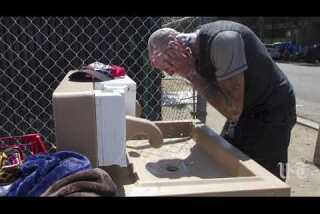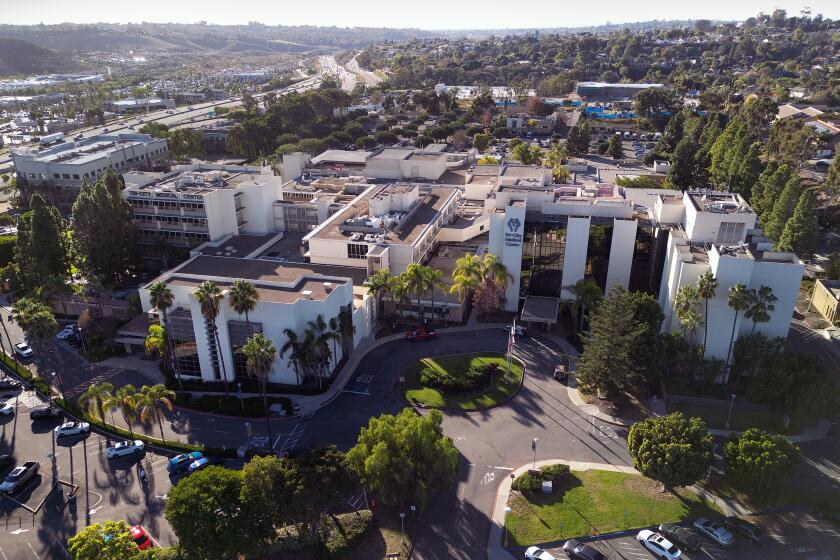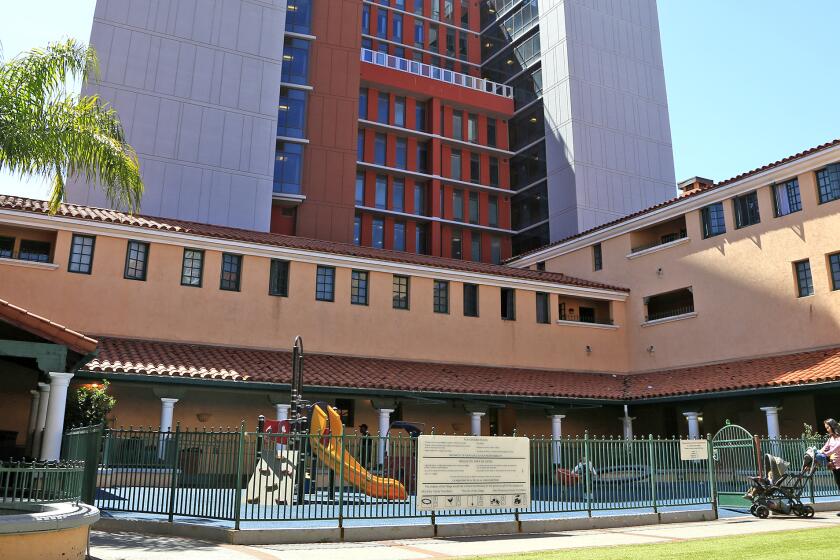Proton therapy center files for bankruptcy
Just three years after opening its doors, San Diego’s only proton therapy center is seeking Chapter 11 bankruptcy protection.
The investment group that owns the $220 million state-of-the-art facility on Summers Ridge Road filed Wednesday under Chapter 11 of the U.S. Bankruptcy Code, stating in court papers that the center “has not operated on a profitable or even a break-even basis.”
The facility is known throughout the region as the Scripps Proton Therapy Center and is operated under contract by the Scripps Clinic Medical Group, which has no ownership stake in the Mira Mesa operation.
At a hearing in Delaware bankruptcy court scheduled for Friday, owner California Proton Treatment Center will ask a judge to approve a $16 million short-term loan to pay for continued operations while a restructuring effort proceeds.
In a statement, the company indicated that patients should not notice a difference.
“Our doors will remain open to administer highly-specialized cancer therapies, and a Patient Ombudsman will ensure that our transition to a new organizational framework won’t affect patients or staff,” said Jette Campbell, the restructuring officer brought on by the company to oversee the bankruptcy reorganization process.
The center opened in 2014 with five treatment bays and a 90-ton cyclotron that used magnets to accelerate protons to two thirds the speed of light. Hopes were high that patients would come flooding in to have tumors of all kinds treated.
Unlike the photons used by more traditional X-ray based machines, protons have mass, which means they can be shot into tumors with just enough force that they’ll stop when they reach the target. Photons, on the other hand, just keep on going, irradiating nearby tissue.
The radiation oncology world has consensus that treating certain kinds of tumors, especially those of the brain, brain stem and spinal cord, definitely benefit from the proton’s ability to limit collateral damage. But the evidence has been less clear in prostate cancer, leading several important health insurance companies to pull coverage in 2014 just as the new center was opening.
Chris Van Gorder, chief executive of Scripps Health, said Thursday that the move away from using protons for prostate cancer, which was estimated to have 180,890 new cases and 26,120 deaths in 2016 alone, hurt the local center.
“Unfortunately (California Proton Treatment Center’s) projections, which they used to build and finance the center, never lived up to their expectations,” Van Gorder said, adding that the number of prostate cases referred were far fewer than seemed reasonable during planning and construction.
Nonetheless, the executive said Scripps has fought tumors in 1,167 patients so far, including many in pediatric patients whose risk of developing secondary cancers later in life from radiation therapy is much higher than adults.
“There is no question that this program, and this center, has saved lives, adults and children, that probably had no chance of survival without proton,” Van Gorder said.
At one time, the San Diego center was one of four built or being built by La Jolla-based Advanced Particle Therapy. Though a center it built in Baltimore is up and running, a sister facility in Dallas has also filed for bankruptcy. A project in Atlanta just secured new financing after a brief stint in bankruptcy.
So far, court filings are relatively scant on details about how, exactly, a restructuring effort will turn things around in San Diego. As the bankruptcy process moves forward, managers will be required to file a more formal plan that indicates how investors will be paid and also how operations might change to make the center more profitable.
Jette Campbell, the restructuring officer, was not available Thursday to provide more detail, and Jeffrey Bordok, the former chief executive of now-defunct Advanced Particle Therapy, had no comment.
Van Gorder said he believes the center can find its financial equilibrium.
“It has been able to cover it’s operating expenses. What it has not been able to pay back is the debt,” Van Gorder said.
There are some big bills to pay. Court filings indicate that proton therapy is a power-hungry enterprise with a $123,000 average monthly utility bill. As part of its bankruptcy filing the center is asking a judge to prevent San Diego Gas and Electric from shutting off the power while restructuring is under way.
Health Playlist


Video: Leaders urge public to help extinguish hepatitis outbreak

San Diego starts cleansing sidewalks, streets to combat hepatitis A

Video: Scripps to shutter its hospice service

Video: Scripps La Jolla hospitals nab top local spot in annual hospital rankings

Video: Does a parent's Alzheimer's doom their children?

EpiPen recall expands

Kids can add years to your life
paul.sisson@sduniontribune.com
(619) 293-1850
Twitter: @paulsisson
Get Essential San Diego, weekday mornings
Get top headlines from the Union-Tribune in your inbox weekday mornings, including top news, local, sports, business, entertainment and opinion.
You may occasionally receive promotional content from the San Diego Union-Tribune.












